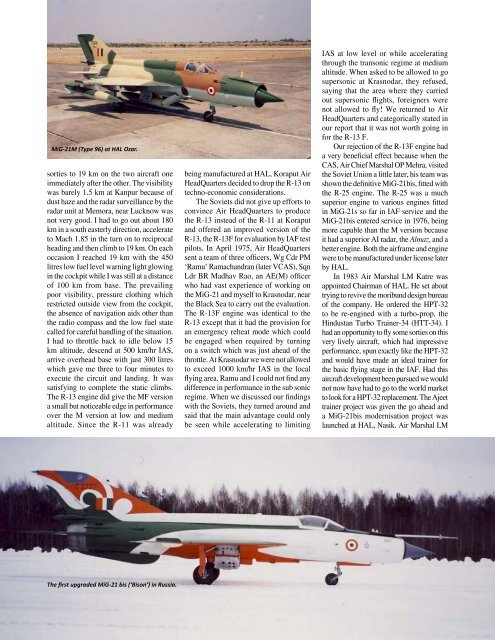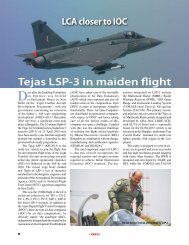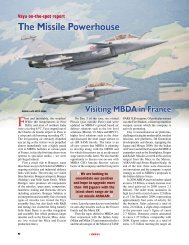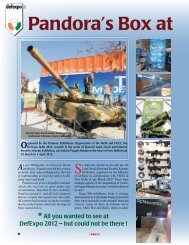The Tortuous MiG-21 Upgrade Saga - Vayu Aerospace
The Tortuous MiG-21 Upgrade Saga - Vayu Aerospace
The Tortuous MiG-21 Upgrade Saga - Vayu Aerospace
You also want an ePaper? Increase the reach of your titles
YUMPU automatically turns print PDFs into web optimized ePapers that Google loves.
<strong>MiG</strong>-<strong>21</strong>M (Type 96) at HAL Ozar.sorties to 19 km on the two aircraft oneimmediately after the other. <strong>The</strong> visibilitywas barely 1.5 km at Kanpur because ofdust haze and the radar surveillance by theradar unit at Memora, near Lucknow wasnot very good. I had to go out about 180km in a south easterly direction, accelerateto Mach 1.85 in the turn on to reciprocalheading and then climb to 19 km. On eachoccasion I reached 19 km with the 450litres low fuel level warning light glowingin the cockpit while I was still at a distanceof 100 km from base. <strong>The</strong> prevailingpoor visibility, pressure clothing whichrestricted outside view from the cockpit,the absence of navigation aids other thanthe radio compass and the low fuel statecalled for careful handling of the situation.I had to throttle back to idle below 15km altitude, descend at 500 km/hr IAS,arrive overhead base with just 300 litreswhich gave me three to four minutes toexecute the circuit and landing. It wassatisfying to complete the static climbs.<strong>The</strong> R-13 engine did give the MF versiona small but noticeable edge in performanceover the M version at low and mediumaltitude. Since the R-11 was alreadybeing manufactured at HAL, Koraput AirHeadQuarters decided to drop the R-13 ontechno-economic considerations.<strong>The</strong> Soviets did not give up efforts toconvince Air HeadQuarters to producethe R-13 instead of the R-11 at Koraputand offered an improved version of theR-13, the R-13F for evaluation by IAF testpilots. In April 1975, Air HeadQuarterssent a team of three officers, Wg Cdr PM‘Ramu’ Ramachandran (later VCAS), SqnLdr BR Madhav Rao, an AE(M) officerwho had vast experience of working onthe <strong>MiG</strong>-<strong>21</strong> and myself to Krasnodar, nearthe Black Sea to carry out the evaluation.<strong>The</strong> R-13F engine was identical to theR-13 except that it had the provision foran emergency reheat mode which couldbe engaged when required by turningon a switch which was just ahead of thethrottle. At Krasnodar we were not allowedto exceed 1000 km/hr IAS in the localflying area. Ramu and I could not find anydifference in performance in the sub sonicregime. When we discussed our findingswith the Soviets, they turned around andsaid that the main advantage could onlybe seen while accelerating to limitingIAS at low level or while acceleratingthrough the transonic regime at mediumaltitude. When asked to be allowed to gosupersonic at Krasnodar, they refused,saying that the area where they carriedout supersonic flights, foreigners werenot allowed to fly! We returned to AirHeadQuarters and categorically stated inour report that it was not worth going infor the R-13 F.Our rejection of the R-13F engine hada very beneficial effect because when theCAS, Air Chief Marshal OP Mehra, visitedthe Soviet Union a little later, his team wasshown the definitive <strong>MiG</strong>-<strong>21</strong>bis, fitted withthe R-25 engine. <strong>The</strong> R-25 was a muchsuperior engine to various engines fittedin <strong>MiG</strong>-<strong>21</strong>s so far in IAF service and the<strong>MiG</strong>-<strong>21</strong>bis entered service in 1976, beingmore capable than the M version becauseit had a superior AI radar, the Almaz, and abetter engine. Both the airframe and enginewere to be manufactured under license laterby HAL.In 1983 Air Marshal LM Katre wasappointed Chairman of HAL. He set abouttrying to revive the moribund design bureauof the company. He ordered the HPT-32to be re-engined with a turbo-prop, theHindustan Turbo Trainer-34 (HTT-34). Ihad an opportunity to fly some sorties on thisvery lively aircraft, which had impressiveperformance, spun exactly like the HPT-32and would have made an ideal trainer forthe basic flying stage in the IAF. Had thisaircraft development been pursued we wouldnot now have had to go to the world marketto look for a HPT-32 replacement. <strong>The</strong> Ajeettrainer project was given the go ahead anda <strong>MiG</strong>-<strong>21</strong>bis modernisation project waslaunched at HAL, Nasik. Air Marshal LM<strong>The</strong> first upgraded <strong>MiG</strong>-<strong>21</strong> bis (‘Bison’) in Russia.78 VAYU76-81 Testing Times.indd 78 6/8/2012 5:41:31 PM








